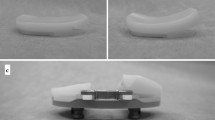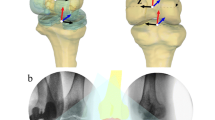Abstract
Purpose
This study aimed to clarify the natural knee kinematics provided by bicruciate-retaining total knee arthroplasty (BCR-TKA) compared with those of unicompartmental knee arthroplasty (UKA) and normal knees.
Methods
Volunteers and patients who had undergone UKA and BCR-TKA with anatomical articular surface performed squatting motion under fluoroscopy. To estimate the knee’s spatial position and orientation, a two-dimensional/three-dimensional registration technique was used. The rotation angle and anteroposterior translation of the medial and lateral sides of the femur relative to the tibia in each flexion angle were directly evaluated using the same local coordinate system and their differences amongst the three groups were analysed using two-way analysis of variance and Bonferroni post hoc pairwise comparison.
Results
From 0° to 10° of flexion, the femoral external rotation angle of BCR-TKA knees was significantly greater than that of normal and UKA knees and the medial side of BCR-TKA knees was significantly more anteriorly located than that of normal and UKA knees. From 40° to 50° of flexion, the medial side of UKA knees was significantly more posteriorly located than that of normal and BCR-TKA knees. From 30° to 120° of flexion, the lateral side of BCR-TKA knees was significantly more anteriorly located than that of normal and UKA knees.
Conclusion
The in vivo kinematics of BCR-TKA knees reproduces those of normal knees to a lower extent than those of UKA knees. Thus, BCR-TKA with anatomical articular surface reproduces in vivo kinematics of normal knees to a lower extent than UKA.
Level of evidence
III.






Similar content being viewed by others
Abbreviations
- KSS 2011:
-
2011 Knee Society Score
- 2D:
-
Two-dimensional
- 3D:
-
Three-dimensional
- ACL:
-
Anterior cruciate ligament
- ANOVA:
-
Analysis of variance
- AP:
-
Anteroposterior
- BCR-TKA:
-
Bicruciate-retaining total knee arthroplasty
- CAD:
-
Computer-aided design
- CR:
-
Cruciate-retaining
- CR-TKA:
-
Cruciate-retaining total knee arthroplasty
- CT:
-
Computed tomography
- DKB:
-
Deep knee bend
- FB:
-
Fixed bearing
- HKA:
-
Hip-knee-ankle
- KSS:
-
Knee Society Score
- LCS:
-
Local coordinate system
- MB:
-
Mobile-bearing
- OA:
-
Osteoarthritis
- PCL:
-
Posterior cruciate ligament
- PRO:
-
Patient-reported outcome
- PS:
-
Posterior-stabilised
- PS-TKA:
-
Posterior-stabilised total knee arthroplasty
- SD:
-
Standard deviation
- TKA:
-
Total knee arthroplasty
- UKA:
-
Unicompartmental knee arthroplasty
References
Arauz P, Klemt C, Limmahakhun S, An S, Kwon YM (2018) Stair climbing and high knee flexion activities in bi-cruciate retaining total knee arthroplasty: in vivo kinematics and articular contact analysis. J Arthroplasty 34:570–576
Arauz P, Peng Y, Kwon YM (2018) Knee motion symmetry was not restored in patients with unilateral bi-cruciate retaining total knee arthroplasty-in vivo three-dimensional kinematic analysis. Int Orthop 42:2817–2823
Audette MA, Ferrie FP, Peters TM (2000) An algorithmic overview of surface registration techniques for medical imaging. Med Image Anal 4:201–217
Bourne RB, Chesworth BM, Davis AM, Mahomed NN, Charron KD (2010) Patient satisfaction after total knee arthroplasty: who is satisfied and who is not? Clin Orthop Relat Res 468:57–63
Cracchiolo A 3rd, Benson M, Finerman GA, Horacek K, Amstutz HC (1979) A prospective comparative clinical analysis of the first-generation knee replacements: polycentric vs. geometric knee arthroplasty. Clin Orthop Relat Res 145:37–46
Dennis DA, Komistek RD, Colwell CE Jr., Ranawat CS, Scott RD, Thornhill TS et al (1998) In vivo anteroposterior femorotibial translation of total knee arthroplasty: a multicenter analysis. Clin Orthop Relat Res 356:47–57
Dennis DA, Komistek RD, Mahfouz MR, Walker SA, Tucker A (2004) A multicenter analysis of axial femorotibial rotation after total knee arthroplasty. Clin Orthop Relat Res 428:180–189
Fuss FK (1992) Principles and mechanisms of automatic rotation during terminal extension in the human knee joint. J Anat 180(Pt 2):297–304
Grieco TF, Sharma A, Dessinger GM, Cates HE, Komistek RD (2017) In vivo kinematic comparison of a bicruciate stabilized total knee arthroplasty and the normal knee using fluoroscopy. J Arthroplasty 33:565–571
Grood ES, Suntay WJ (1983) A joint coordinate system for the clinical description of three-dimensional motions: application to the knee. J Biomech Eng 105:136–144
Gunston FH (1971) Polycentric knee arthroplasty. Prosthetic simulation of normal knee movement. J Bone Jt Surg Br 53:272–277
Halewood C, Traynor A, Bellemans J, Victor J, Amis AA (2015) Anteroposterior laxity after bicruciate-retaining total knee arthroplasty is closer to the native knee than ACL-resecting TKA: a biomechanical cadaver study. J Arthroplasty 30:2315–2319
Hallen LG, Lindahl O (1966) The “screw-home” movement in the knee-joint. Acta Orthop Scand 37:97–106
Hamai S, Moro-oka TA, Miura H, Shimoto T, Higaki H, Fregly BJ et al (2009) Knee kinematics in medial osteoarthritis during in vivo weight-bearing activities. J Orthop Res 27:1555–1561
Heyse TJ, El-Zayat BF, De Corte R, Chevalier Y, Scheys L, Innocenti B et al (2014) UKA closely preserves natural knee kinematics in vitro. Knee Surg Sports Traumatol Arthrosc 22:1902–1910
Horiuchi H, Akizuki S, Tomita T, Sugamoto K, Yamazaki T, Shimizu N (2012) In vivo kinematic analysis of cruciate-retaining total knee arthroplasty during weight-bearing and non–weight-bearing deep knee bending. J Arthroplasty 27:1196–1202
Inui H, Taketomi S, Nakamura K, Sanada T, Tanaka S, Nakagawa T (2013) An additional reference axis improves femoral rotation alignment in image-free computer navigation assisted total knee arthroplasty. J Arthroplasty 28:766–771
Inui H, Taketomi S, Nakamura K, Takei S, Takeda H, Tanaka S et al (2013) Influence of navigation system updates on total knee arthroplasty. BMC Sports Sci Med Rehabil 5:10
Kanda Y (2013) Investigation of the freely available easy-to-use software ‘EZR’ for medical statistics. Bone Marrow Transplant 48:452–458
Kono K, Inui H, Tomita T, Yamazaki T, Taketomi S, Sugamoto K et al (2019) Bicruciate-stabilised total knee arthroplasty provides good functional stability during high-flexion weight-bearing activities. Knee Surg Sports Traumatol Arthrosc 10:1–8
Kono K, Tomita T, Futai K, Yamazaki T, Tanaka S, Yoshikawa H et al (2018) In vivo three-dimensional kinematics of normal knees during different high-flexion activities. Bone Jt J 100-b:50–55
Liddle AD, Pandit H, Judge A, Murray DW (2015) Patient-reported outcomes after total and unicompartmental knee arthroplasty: a study of 14,076 matched patients from the National Joint Registry for England and Wales. Bone Jt J 97-b:793–801
Long WJ, Bryce CD, Hollenbeak CS, Benner RW, Scott WN (2014) Total knee replacement in young, active patients: long-term follow-up and functional outcome: a concise follow-up of a previous report. J Bone Jt Surg Am 96:e159
Mochizuki T, Sato T, Blaha JD, Tanifuji O, Kobayashi K, Yamagiwa H et al (2014) Kinematics of the knee after unicompartmental arthroplasty is not the same as normal and is similar to the kinematics of the knee with osteoarthritis. Knee Surg Sports Traumatol Arthrosc 22:1911–1917
Moglo KE, Shirazi-Adl A (2005) Cruciate coupling and screw-home mechanism in passive knee joint during extension–flexion. J Biomech 38:1075–1083
Mont MA, John M, Johnson A (2012) Bicruciate retaining arthroplasty. Surg Technol Int 22:236–242
Nam D, Nunley RM, Barrack RL (2014) Patient dissatisfaction following total knee replacement: a growing concern? Bone Jt J 96-b:96–100
Okada Y, Teramoto A, Takagi T, Yamakawa S, Sakakibara Y, Shoji H et al (2018) ACL function in bicruciate-retaining total knee arthroplasty. J Bone Jt Surg Am 100:e114
Patil S, Colwell CW Jr, Ezzet KA, D'Lima DD (2005) Can normal knee kinematics be restored with unicompartmental knee replacement? J Bone Jt Surg Am 87:332–338
Pritchett JW (2015) Bicruciate-retaining total knee replacement provides satisfactory function and implant survivorship at 23 years. Clin Orthop Relat Res 473:2327–2333
Sabouret P, Lavoie F, Cloutier JM (2013) Total knee replacement with retention of both cruciate ligaments: a 22-year follow-up study. Bone Jt J 95-b:917–922
Shimizu N, Tomita T, Yamazaki T, Yoshikawa H, Sugamoto K (2011) The effect of weight-bearing condition on kinematics of a high-flexion, posterior-stabilized knee prosthesis. J Arthroplasty 26:1031–1037
Stiehl JB, Komistek RD, Cloutier JM, Dennis DA (2000) The cruciate ligaments in total knee arthroplasty: a kinematic analysis of 2 total knee arthroplasties. J Arthroplasty 15:545–550
Tamaki M, Tomita T, Yamazaki T, Hozack WJ, Yoshikawa H, Sugamoto K (2008) In vivo kinematic analysis of a high-flexion posterior stabilized fixed-bearing knee prosthesis in deep knee-bending motion. J Arthroplasty 23:879–885
Tsai TY, Liow MHL, Peng Y, Paul A, Li G, Kwon YM (2018) In-vivo elongation of anterior and posterior cruciate ligament in bi-cruciate retaining total knee arthroplasty. J Orthop Res 36:3239–3246
Von Keudell A, Sodha S, Collins J, Minas T, Fitz W, Gomoll AH (2014) Patient satisfaction after primary total and unicompartmental knee arthroplasty: an age-dependent analysis. Knee 21:180–184
Yamazaki T, Watanabe T, Nakajima Y, Sugamoto K, Tomita T, Yoshikawa H et al (2004) Improvement of depth position in 2-D/3-D registration of knee implants using single-plane fluoroscopy. IEEE Trans Med Imaging 23:602–612
Yoshiya S, Matsui N, Komistek RD, Dennis DA, Mahfouz M, Kurosaka M (2005) In vivo kinematic comparison of posterior cruciate-retaining and posterior stabilized total knee arthroplasties under passive and weight-bearing conditions. J Arthroplasty 20:777–783
Zumbrunn T, Duffy MP, Rubash HE, Malchau H, Muratoglu OK, Varadarajan KM (2008) ACL substitution may improve kinematics of PCL-retaining total knee arthroplasty. Knee Surg Sports Traumatol Arthrosc 26:1445–1454
Acknowledgements
We are grateful to Dr. Ryota Yamagami, Dr. Kohei Kawaguchi, Dr. Tomofumi Kage, Dr. Teruya Ishibashi and Dr. Shoji Konda for their cooperation in this research. We also thank our colleagues for their constructive comments. This research did not receive any specific grant from any funding agencies in the public, commercial or not-for-profit sectors.
Funding
There is no funding source.
Author information
Authors and Affiliations
Corresponding author
Ethics declarations
Conflict of interest
We declare that we have no conflict of interest.
Ethical approval
Institutional review board approval was rececived for this study.
Additional information
Publisher's Note
Springer Nature remains neutral with regard to jurisdictional claims in published maps and institutional affiliations.
Electronic supplementary material
Below is the link to the electronic supplementary material.
Fluoroscopic analysis. Under fluoroscopy, each participant performed a squatting motion at a natural pace (WMV 5569 kb)
Two-dimensional/three-dimensional (2D/3D) registration of bicruciate-retaining total knee arthroplasty knee during squatting motion. The 2D/3D registration of the femoral and tibial implants was performed initially, followed by the 2D/3D registration of the femoral and tibial bone models (WMV 5541 kb)
Rights and permissions
About this article
Cite this article
Kono, K., Inui, H., Tomita, T. et al. Bicruciate-retaining total knee arthroplasty reproduces in vivo kinematics of normal knees to a lower extent than unicompartmental knee arthroplasty. Knee Surg Sports Traumatol Arthrosc 28, 3007–3015 (2020). https://doi.org/10.1007/s00167-019-05754-2
Received:
Accepted:
Published:
Issue Date:
DOI: https://doi.org/10.1007/s00167-019-05754-2




